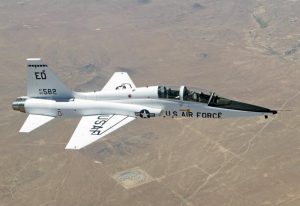17 March 1959 – “In the mid-1950s the USAF issued a General Operating Requirement for a supersonic trainer, planning to retire its 1940s-era Lockheed T-33s. Northrop officials decided to adapt the N-156 to this competition. The only other candidate was the two-seat version of the North American F-100 Super Sabre. Although the F-100 was not considered the ideal candidate for a training aircraft (it is not capable of recovering from a spin – [see note]), NAA was still considered the favorite in the competition due to that company’s favored-contractor status with the Air Force.
 However, Northrop officials convincingly presented life-cycle cost comparisons which could not be ignored, and they were awarded the contract, receiving an order for three prototypes. The first (designated YT-38) flew on 10 April 1959. The type was quickly adopted and the first production examples were delivered in 1961, officially entering service on 17 March that year, complementing the T-37 primary jet trainer. When production ended in 1972, 1,187 T-38s had been built (plus two N-156T prototypes). Since its introduction, it is estimated that some 50,000 military pilots have trained on this aircraft. The USAF remains one of the few armed flying forces using dedicated supersonic final trainers, as most, such as the US Navy, use high subsonic trainers.
However, Northrop officials convincingly presented life-cycle cost comparisons which could not be ignored, and they were awarded the contract, receiving an order for three prototypes. The first (designated YT-38) flew on 10 April 1959. The type was quickly adopted and the first production examples were delivered in 1961, officially entering service on 17 March that year, complementing the T-37 primary jet trainer. When production ended in 1972, 1,187 T-38s had been built (plus two N-156T prototypes). Since its introduction, it is estimated that some 50,000 military pilots have trained on this aircraft. The USAF remains one of the few armed flying forces using dedicated supersonic final trainers, as most, such as the US Navy, use high subsonic trainers.
The United States Air Force (USAF) operates the most T-38s. In addition to training USAF pilots, the T-38 is used by NASA.” (1)
Note about the spin: “A problem the Air Force once had was at the prestigious Fighter Weapons School at Nellis AFB, NV. During mock dogfights or air combat maneuvering, it had become vogue by some instructors with no combat experience to allow an encounter to degenerate into a slow-speed contest. (In combat you never slow down to near stall speed unless you have a death wish.)
The airplane was the F-100 Super Sabre. It had very strong adverse yaw when ailerons were deflected. At a slow airspeed, an abrupt aileron input would quickly snap the aircraft into an over-the-top spin. For example, a hard-right control input caused adverse yaw from the downgoing left aileron to precipitate a snap over the top to the left.
It was easily recoverable, again by using adverse yaw. For example, when spinning to the left, place the control stick full left, or with the direction of rotation. Adverse yaw from the downward deflected right aileron was more powerful than rudder and recovery occurred quickly.” (2)
Source: (1) Wikipedia; (2) Spinning a Tangled Web – Aviation Safety
